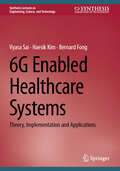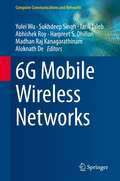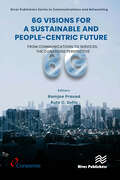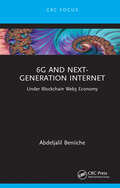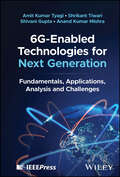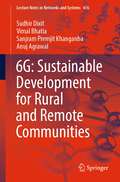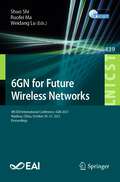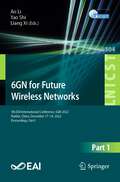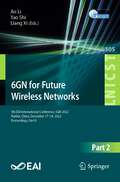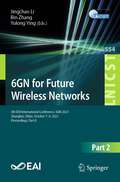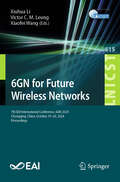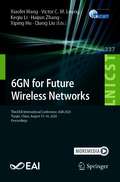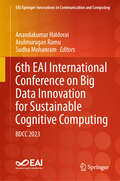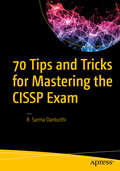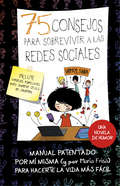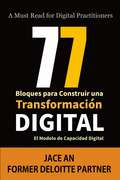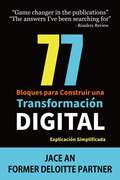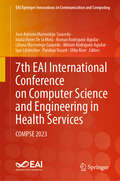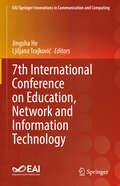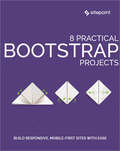- Table View
- List View
6G Enabled Healthcare Systems: Theory, Implementation and Applications (Synthesis Lectures on Engineering, Science, and Technology)
by Bernard Fong Haesik Kim Vyasa SaiThis book introduces 6G enabled healthcare systems and helps readers understand state-of-the-art techniques and applications for future healthcare systems. Readers will be able to obtain a background knowledge about AI, wireless systems, implementation methods, and applications, enabling the upcoming migration from 5G to 6G for supporting mission-critical healthcare applications.
6G Mobile Wireless Networks (Computer Communications and Networks)
by Yulei Wu Abhishek Roy Sukhdeep Singh Tarik Taleb Harpreet S. Dhillon Madhan Raj Kanagarathinam Aloknath DeThis book is the world’s first book on 6G Mobile Wireless Networks that aims to provide a comprehensive understanding of key drivers, use cases, research requirements, challenges and open issues that are expected to drive 6G research. In this book, we have invited world-renowned experts from industry and academia to share their thoughts on different aspects of 6G research. Specifically, this book covers the following topics: 6G Use Cases, Requirements, Metrics and Enabling Technologies, PHY Technologies for 6G Wireless, Reconfigurable Intelligent Surface for 6G Wireless Networks, Millimeter-wave and Terahertz Spectrum for 6G Wireless, Challenges in Transport Layer for Tbit/s Communications, High-capacity Backhaul Connectivity for 6G Wireless, Cloud Native Approach for 6G Wireless Networks, Machine Type Communications in 6G, Edge Intelligence and Pervasive AI in 6G, Blockchain: Foundations and Role in 6G, Role of Open-source Platforms in 6G, and Quantum Computing and 6G Wireless. The overarching aim of this book is to explore the evolution from current 5G networks towards the future 6G networks from a service, air interface and network perspective, thereby laying out a vision for 6G networks. This book not only discusses the potential 6G use cases, requirements, metrics and enabling technologies, but also discusses the emerging technologies and topics such as 6G PHY technologies, reconfigurable intelligent surface, millimeter-wave and THz communications, visible light communications, transport layer for Tbit/s communications, high-capacity backhaul connectivity, cloud native approach, machine-type communications, edge intelligence and pervasive AI, network security and blockchain, and the role of open-source platform in 6G. This book provides a systematic treatment of the state-of-the-art in these emerging topics and their role in supporting a wide variety of verticals in the future. As such, it provides a comprehensive overview of the expected applications of 6G with a detailed discussion of their requirements and possible enabling technologies. This book also outlines the possible challenges and research directions to facilitate the future research and development of 6G mobile wireless networks.
6G Visions for a Sustainable and People-centric Future: From Communications to Services, the CONASENSE Perspective (River Publishers Series in Communications and Networking)
by Ramjee Prasad Rute C. Sofia6G is currently under definition, being often addressed from a plain telecommunications perspective as an evolutionary paradigm that represents an extension of 5G. Having as a horizon 2030, 6G initiatives are being deployed across the globe to further ignite the development of 6G services. At its philosophical core, 6G embodies the "human in the loop" principle. The research effort being developed towards 6G requires an interdisciplinary approach that ignites discussion across different key technological sectors, ranging from communications up to services and business cases. The contributions of this book to research in the field concern an evolutionary and interdisciplinary design of 6G as a paradigm that can be addressed by working together four different computational areas: communications; satellites and navigation; sensing; services. The book is derived from initial brainstorming that was developed during the 11th CONASENSE Symposium held in October 2021 in fortiss, Munich, Germany. Several international experts contribute to an overview of 6G key challenges, new networking trends and challenges to be overcome, and advanced 6G services. The book starts with a perspective on 6G challenges and use-cases beyond the 2030 horizon, to then continue to address the role of non-terrestrial networks and cognitive, service-centric satellite networks in future 6G services. Still with focus on 6G adaptive networking, the book continues with a debate on the need to integrate social awareness based on an interdisciplinary approach in network operations. Then, specific examples of advanced services (quantum imaging and holography; localization of the Internet of remote things) are discussed. The book is, therefore, intended to assist in developing critical thinking to back up novel networking, applications, and services towards 6G.
6G and Next-Generation Internet: Under Blockchain Web3 Economy
by Abdeljalil BeniicheThe sixth generation (6G) of wireless cellular networks is expected to incorporate the latest developments in network infrastructure and emerging advances in technology. It will not only explore more spectrum at high-frequency bands but also converge driving technological trends, including connected robotics, artificial intelligence (AI), and blockchain technologies. There is also a strong notion that the nature of mobile terminals will change, whereby intelligent mobile robots are anticipated to play a more important role. Importantly, 6G will become more human-centered than 5G, which primarily focused on industry verticals. This book explores the human-centeredness of blockchain and Web3 economy for the 6G era. Aimed at graduate students, network and blockchain researchers, professionals, engineers, and practitioners, this book discusses the symbiosis of blockchain with other key technologies such as AI and robots, while putting the focus on the Tactile Internet for advanced human-to-machine interaction. By focusing on the research field of robonomics in the 6G Era, which studies the social integration of robots into the economy and human society, the book puts the various developed ideas and concepts into the perspective of the future Super Smart Society 5.0.
6G-Enabled Technologies for Next Generation: Fundamentals, Applications, Analysis and Challenges
by Shivani Gupta Amit Kumar Tyagi Shrikant Tiwari Anand Kumar MishraA comprehensive reference on 6G wireless technologies, covering applications, hardware, security and privacy concerns, existing challenges, analytics methods, and much more 6G-Enabled Technologies for Next Generation delivers a thorough overview of the emerging sixth generation of wireless technology, presenting critical challenges of implementing 6G technologies including spectrum allocation, energy efficiency, security, interoperability, and more. Explaining ways we can use technologies to ensure a sustainable environment through renewable energy and a resilient industry, this book covers the applications and use cases such as smart grid, IoT, smart manufacturing, addressing security and privacy issues with privacy-preserving techniques and authentication control mechanisms. This book discusses the analytical methods used to study the performance of 6G technologies, covering simulation techniques, performance metrics, and predictive modeling. Introducing the core principles of 6G technology, including the advantages and disadvantages of the technology and how wireless communications have evolved, energy-efficient hardware and the different types of green communication technologies is explained. Many case studies are included in this book with a detailed explanation. Written by a team of experienced researchers, this book discusses: Terahertz (ThZ) communication, massive MIMO and beamforming, quantum communication, bandwidth management, and ultra-dense networks and small cell deployments Smart cities, telemedicine, and autonomous vehicles and schemes for waveform design, modulation, error correction, and advanced coding and modulation Sensor networks, edge computing and mobile cloud computing, and spatial, quantum, and dew computing Quantum-safe encryption, privacy-preserving technologies and techniques, threats and vulnerabilities, and authentication and access control mechanisms Network slicing and service differentiation, multi-connectivity and heterogeneous networks, and wireless power transfer 6G-Enabled Technologies for Next Generation is a comprehensive, up-to-date reference for students, academics, and researchers, along with professionals in the telecommunications field.
6G: Sustainable Development for Rural and Remote Communities (Lecture Notes in Networks and Systems #416)
by Sudhir Dixit Vimal Bhatia Sanjram Premjit Khanganba Anuj AgrawalThe book covers a variety of feasible technology options, both wired and wireless, to enable 6G connectivity in rural and remote regions. Along with the enabling technology options, the book also covers important aspects such as human-computer interaction, business models for the local operator ecosystem, regulatory and right-of-way policies, security and privacy, and future challenges related to technology migration, urbanization, and scalability. A special feature of this book is that it covers both the optical and wireless technology aspects to realize 6G connectivity, which will be of interest to a broad range of researchers and practitioners. Detailed figures have been included in the book to cover both the fiber-optics and wireless aspects. These figures include telecommunication equipment and networks ranging from a locality to the under-sea cables to high latitude platforms. The book has simple explanations, pictorial representations, minimal math, and conversational language, which will enable all the readers to grasp it, thereby helping them in decision making and performing comprehensive analysis. This book includes the needs of the unconnected and under-connected sections of the society, notably from the rural and remote areas, when the 6G standards are being discussed and developed. This feature will help overcome the challenge of widening the digital divide from every new generation of mobile network standards. Hence, the book covers all technical and non-technical aspects to be of interest to researchers, decision-makers, academia, social workers, and the readers in technology, growth, and empowerment.
6GN for Future Wireless Networks: 4th EAI International Conference, 6GN 2021, Huizhou, China, October 30–31, 2021, Proceedings (Lecture Notes of the Institute for Computer Sciences, Social Informatics and Telecommunications Engineering #439)
by Shuo Shi Ruofei Ma Weidang LuThis book constitutes the proceedings of the 4th International Conference on 6G for Future Wireless Networks, 6GN 2021, held in Huizhou, China, in October 2021. The 63 full papers were selected from 136 submissions and present the state of the art and practical applications of 6G technologies. The papers are arranged thematically in tracks as follows: Advanced Communication and Networking Technologies for 5G/6G Networks; Advanced Signal Processing Technologies for 5G/6G Networks; and Educational Changes in The Age of 5G/6G.
6GN for Future Wireless Networks: 5th EAI International Conference, 6GN 2022, Harbin, China, December 17-18, 2022, Proceedings, Part I (Lecture Notes of the Institute for Computer Sciences, Social Informatics and Telecommunications Engineering #504)
by Ao Li Yao Shi Liang XiThis 2-volume set constitutes the proceedings of the 5th International Conference on 6G for Future Wireless Networks, 6GN 2022, held in Harbin, China, in December 2022. The 60 full papers were selected from 194 submissions and present the state of the art and practical applications of 6G technologies. The papers are arranged thematically in tracks as follows: Resource Allocation for 6G Networks; Security and Privacy for 6G Networks; Big data mining and pattern analysis techniques for 6G Networks; Artificial intelligent techniques for 6G Networks; Mobile Edge Computing for 6G Networks; Unmanned Aerial Vehicle Communication for 6G Networks.
6GN for Future Wireless Networks: 5th EAI International Conference, 6GN 2022, Harbin, China, December 17-18, 2022, Proceedings, Part II (Lecture Notes of the Institute for Computer Sciences, Social Informatics and Telecommunications Engineering #505)
by Ao Li Yao Shi Liang XiThis 2-volume set constitutes the proceedings of the 5th International Conference on 6G for Future Wireless Networks, 6GN 2022, held in Harbin, China, in December 2022.The 60 full papers were selected from 194 submissions and present the state of the art and practical applications of 6G technologies. The papers are arranged thematically in tracks as follows: Resource Allocation for 6G Networks; Security and Privacy for 6G Networks; Big data mining and pattern analysis techniques for 6G Networks; Artificial intelligent techniques for 6G Networks; Mobile Edge Computing for 6G Networks; Unmanned Aerial Vehicle Communication for 6G Networks.
6GN for Future Wireless Networks: 6th EAI International Conference, 6GN 2023, Shanghai, China, October 7-8, 2023, Proceedings, Part I (Lecture Notes of the Institute for Computer Sciences, Social Informatics and Telecommunications Engineering #553)
by Bin Zhang Jingchao Li Yulong YingThis 2-volume set constitutes the proceedings of the 6th EAI International Conference on 6GN for Future Wireless Networks, 6GN 2023, held in Shanghai, China, in October 7-8, 2023. The 60 full papers were selected from 151 submissions and present the state of the art and practical applications of 6G technologies. The papers are arranged thematically in tracks as follows: intelligent systems; big data mining, D2D communication, security and privacy for 6G networks; artificial intelligent techniques for 6G networks; power and energy systems I; power and energy system; power and energy systems; image, video, and signal processing; image, video, and signal processing & software engineering; communications systems and networking & control and automation systems; computer systems and applications.
6GN for Future Wireless Networks: 6th EAI International Conference, 6GN 2023, Shanghai, China, October 7-8, 2023, Proceedings, Part II (Lecture Notes of the Institute for Computer Sciences, Social Informatics and Telecommunications Engineering #554)
by Bin Zhang Jingchao Li Yulong YingThis 2-volume set constitutes the proceedings of the 6th EAI International Conference on 6GN for Future Wireless Networks, 6GN 2023, held in Shanghai, China, in October 7-8, 2023.The 60 full papers were selected from 151 submissions and present the state of the art and practical applications of 6G technologies. The papers are arranged thematically in tracks as follows: intelligent systems; big data mining, D2D communication, security and privacy for 6G networks; artificial intelligent techniques for 6G networks; power and energy systems I; power and energy system; power and energy systems; image, video, and signal processing; image, video, and signal processing & software engineering; communications systems and networking & control and automation systems; computer systems and applications.
6GN for Future Wireless Networks: 7th EAI International Conference, 6GN 2024, Chongqing, China, October 19–20, 2024, Proceedings (Lecture Notes of the Institute for Computer Sciences, Social Informatics and Telecommunications Engineering #615)
by Victor C. M. Leung Xiaofei Wang Xiuhua LiThis volume set constitutes the proceedings of the 7th EAI International Conference on 6GN for Future Wireless Networks, 6GN 2024, held in Chongqing, China, in October 19-20, 2024. The 18 papers included in these proceedings were carefully reviewed and selected from50 submissions.They focus on the following topical sections such as Wireless Control and Network Optimization; Edge Computing and Resource Allocation; Intelligent Systems and Simulation; Artificial Intelligence and Digital Economy.
6GN for Future Wireless Networks: Third EAI International Conference, 6GN 2020, Tianjin, China, August 15-16, 2020, Proceedings (Lecture Notes of the Institute for Computer Sciences, Social Informatics and Telecommunications Engineering #337)
by Keqiu Li Victor C. M. Leung Haijun Zhang Qiang Liu Xiaofei Wang Xiping HuThis book constitutes the proceedings of the Third International Conference on 6G for Future Wireless Networks, 6GN 2020, held in Tianjin, China, in August 2020. The conference was held virtually due to the COVID-19 pandemic. The 45 full papers were selected from 109 submissions and present the state of the art and practical applications of 6G technologies. The papers are arranged thematically on network scheduling and optimization; wireless system and platform; intelligent applications; network performance evaluation; cyber security and privacy; technologies for private 5G/6G.
6th EAI International Conference on Big Data Innovation for Sustainable Cognitive Computing: BDCC 2023 (EAI/Springer Innovations in Communication and Computing)
by Anandakumar Haldorai Arulmurugan Ramu Sudha MohanramThis book features the proceedings of the 6th EAI International Conference on Big Data Innovation for Sustainable Cognitive Computing (BDCC 2023). The papers feature detail on cognitive computing and its self-learning systems that use data mining, pattern recognition and natural language processing (NLP) to mirror the way the human brain works. This international conference focuses on technologies from knowledge representation techniques and natural language processing algorithms to dynamic learning approaches. Topics covered include Data Science for Cognitive Analysis, Real-Time Ubiquitous Data Science, Platform for Privacy Preserving Data Science, and Internet-Based Cognitive Platform.
7 Days till Ice Cream: A Makers Story about Coding (Makers Make It Work)
by Bernardo FelicianoIt's Sunday—ice cream day! But sometimes the ice cream truck turns down a different street. Can Jerron, A.J., and Cha crack the ice cream man's code? They want him to come their way! Tying into the popular Makers Movement, Makers Make It Work is a series of fun easy-to-read stories that focus on problem-solving and hands-on action. This charming story explores the Makers theme of Coding and includes explanatory sidebars and a computer coding-related activity for young makers to try themselves!
70 Tips and Tricks for Mastering the CISSP Exam
by R. Sarma DanturthiLearn how to think and apply knowledge in a practical way. Tackling the CISSP exam is vastly different from simply understanding the subject matter. Even the most experienced security professionals can fail because the questions are tricky and ask the test taker to pick the best of the options given. The CISSP exam conducted by ISC2 is the hardest and most rewarded cybersecurity examination. The test has several domains and sub-domains and covers a wide range of topics on security, including cyber and physical building security fields. It also covers breaches, discovery of breaches, and how to report data breaches. Because the subject area is vast and the questions are almost never repeated, it is hard for the exam taker to memorize or quickly discover the correct solution. The four options given as answers typically have two very close matches to the question. With quick analysis, it is possible to discover from the verbiage of a question what is truly being asked and learn how to find the closest possible solution without spending too much time on each question. What You Will Learn Think outside the box (the CISSP exam demands this of candidates)Quickly discern the gist of a question, eliminate the distractors, and select the correct answerUnderstand the use of words such as MOST, BEST, FIRST, LAST in the questionsSelect the correct answer when multiple options look like possible solutions Who This Book Is For Experienced security practitioners, managers, and executives interested in proving their knowledge across a wide array of security practices and principles, including chief information security officers, chief information officers, directors of security, IT directors and managers, security systems engineers, security analysts, security managers, security auditors, security architects, security consultants, private contractors, and network architects
75 consejos para sobrevir a las redes sociales (Serie 75 Consejos #8)
by María Frisa¡¡Llega el volumen número 8 de la exitosa serie «75 consejos», el DIARIO MÁS TRONCHANTE JAMÁS ESCRITO!! Y esta vez no querrás perdértelo, porque lo necesitas: ¿cómo sobrevivir cuando las redes sociales se vuelven en tu contra? ¿Alguna vez un «amigo» ha subido una foto o un vídeo tuyo humillante, de esos que a los demás les hacen mucha gracia (porque no salen) y tú has sido el último en enterarte? ¿Quieres saber qué hacer para intentar pararlo (difícil) o, por lo menos, contrarrestarlo? ¡¡No esperes más, ABRE ESTE LIBRO!! ¡Y aprende de mis 75 superconsejos! Bueno, ejem, ejem, también de mis errores... Y recuerda: si hay algo eterno, es lo que subes a un grupo de WhatsApp, (el sol se apagará, las estrellas desaparecerán, la raza humana se extinguirá, pero tu foto seguirá ahí).
77 Bloques para Construir una Transformación Digital: El Modelo de Capacidad Digital
by Jace AnEste no es un libro sobre teoría que discuta conceptos académicos de transformaración digital, sino que se orienta a la práctica de campo que describe cómo asesorar y mejorar las capacidades digitales de una organización. Más bien satisface mejor a los ‘practicantes digitales’, quienes están involucrados en operaciones de negocios digitales, incluyendo tecnología informática y digital, comercio electrónico, servicios de atención al cliente online y muchas otras áreas operativas en las que la tecnología informática podría tener impacto. La capacidad digital está definida en este libro como la capacidad organizativa y la habilidad para producir resultados de negocio intencionales en el espacio digital al combinar procesos, personas y elementos tecnológicos de un modo único para cada organización. Los elementos del proceso incluyen flujo de proceso, información de entrada y salida; reglas del negocio; políticas y lineamientos. El elemento humano incluye una estructura y cultura organizacional; roles, responsabilidades y habilidades de las personas. Los elementos tecnológicos incluyen aplicaciones; infraestructura de datos; instalaciones y equipos alrededor de la tecnología digital. La capacidad de escucha del diálogo social está definida, por ejemplo, como una capacidad organizativa para entender de qué están hablando los usuarios en las redes sociales y utilizarlo para un negocio al combinar procesos bien definidos, las habilidades del personal y sus evidentes roles y responsabilidades, como también las herramientas de automatización. Una mayor madurez dentro de las capacidades digitales asegura operaciones efectivas y eficientes dentro de los negocios digitales. Las operaciones de los negocios digitales están dentro de un área multidisciplinaria donde convergen los negocios y la Tecnología Informática que trabajan en conjunto para producir resultados comerciales en el espacio digital. Enten
77 Bloques para Construir una Transformación Digital: Explicación Simplificada
by Jace AnEn 2018, ‘77 Bloques para Construir una Transformación Digital: Modelo de Capacidad Digital’ fue publicado para asistir a los ‘practicantes digitales’ quienes trabajan en el espacio digital. Desde entonces, pocos lectores me han sugerido escribir un libro sobre la transformación digital para ‘el público en general’ que estuviere interesado en aprender más que lo básico sobre la transformación digital. Es así que he creado este libro ‘77 Bloques para Construir una Transformación Digital: Explicación Simplificada’. Este libro intenta entregar los mensajes claves de ‘77 Bloques para Construir una Transformación Digital: Modelo de Capacidad Digital’ al público en general. Dicho esto, este no pretende ser un libro de teoría que discuta las ideas y conceptos académicos de la transformación digital, sino un libro práctico de campo que describe las capacidades digitales probadas como los bloques de construcción para la transformación digital. ‘77 Bloques para Construir una Transformación Digital: Explicación Simplificada’ se enfoca en introducir 77 bloques de construcción para asistir al público en general a comprender las ‘prácticas reales’ en el espacio digital, aunque no cubre totalmente el Modelo de Madurez descripto en detalle en ‘77 Bloques para Construir una Transformación Digital: Modelo de Capacidad Digital’ que asiste a los practicantes digitales con indicadores de madurez de las capacidades digitales. Este libro proporciona unos pocos ejemplos de indicadores de mayor madurez como una introducción al Modelo de Madurez de las Capacidades Digitales.
7R: Las siete revoluciones tecnológicas que transformarán nuestra vida
by Joan CwaikEl siglo XXI dejará su huella en la historia gracias al desarrollo de tecnologías emergentes que están generando una revolución que va más allá de lo industrial porque también involucra aspectos sociales, económicos y culturales. Decir que el mundo avanza a pasos agigantados es una frase trillada pero real. Todavía los autos no vuelan y no vacacionamos en el espacio, pero el siglo XXI va a dejar su huella en la historia gracias al desarrollo de las tecnologías emergentes. Aunque la ciencia ficción y la filosofía imaginaron todos estos adelantos, se está generando una nueva revolución que va más allá de lo industrial porque también involucra aspectos sociales, económicos y culturales. Joan Cwaik, investigador y especialista en innovación tecnológica, explica con claridad en qué consisten estos nuevos avances y cómo van a cambiar la vida de las personas. Las criptomonedas, el big data, las ciudades inteligentes, la impresión 3D, los robots, la Internet de las Cosas y la realidad virtual y la aumentada llegaron para quedarse y van a transformarnos para siempre.
7th EAI International Conference on Computer Science and Engineering in Health Services: COMPSE 2023 (EAI/Springer Innovations in Communication and Computing)
by Pandian Vasant Igor Litvinchev Utku Kose Jose Antonio Marmolejo-Saucedo Roman Rodriguez-Aguilar Idalia Flores De la Mota Liliana Marmolejo-Saucedo Miriam Rodriguez-AguilarThis book constitutes the refereed post-conference proceedings of the 7th EAI International Conference on Computer Science and Engineering in Health Services (COMPSE 2023), which took place November 16-17, 2023, in Mexico City, Mexico. The full papers presented were carefully reviewed and selected from dozens of submissions. The papers are grouped on thematic topics: application of tools delivered by the COVID-19 pandemic; health services; computer and data science; and industry 4.0 in logistics and supply chain. The content is relevant to researchers, academics, students and professionals.
7th EAI International Conference on Robotic Sensor Networks: EAI ROSENET 2023 (EAI/Springer Innovations in Communication and Computing)
by Paolo Fiorini Ömer Melih Gül Seifedine Nimer KadryThis book presents the proceedings of the 7th EAI International Conference on Robotics and Networks 2023 (EAI ROSENET 2023). The conference explores the integration of networks, communications, and robotic technologies, which has become a topic of increasing interest for both researchers and developers from academic fields and industries worldwide. The authors posit that big networks will be the main approach to the next generation of robotic research, with the explosive number of communications and networks models and increasing computational power of computers significantly extending the number of potential applications for robotic technologies while also bringing new challenges to the communications and networking community. The conference provided a platform for researchers to share up-to-date scientific achievements in this field. The conference takes place at Bahcesehir University, Istanbul, Türkiye on 15-16 December 2023.
7th International Conference on Education, Network and Information Technology (EAI/Springer Innovations in Communication and Computing)
by Jingsha He Ljiljana TrajkovićThis book presents the proceedings of the 7th International Conference on Education, Network and Information Technology (ICENIT2024), which took place in Dalian, China, on August 16-18, 2024. The conference provides a platform for relevant scholars and researchers to discuss the impact of network and information technology on education, improve the research and application level of domestic education, and promote academic exchanges in related fields as well. Topics include web classroom applications, technology-enhanced learning, computer distance education, AI in education, digital libraries information system applications, and more. The conference is relevant to researchers, professionals, practitioners, and students in education, and IT. Presents the proceedings of the 7th International Conference on Education, Network and Information Technology (ICENIT2024) Provides a platform to discuss the impact of network and information technology on education Relevant to researchers, professionals, practitioners, and students in education, and IT
8 Ball Pool: guía no oficial
by Joshua Abbott Mario AntuñaGUÍA NO OFICIAL Guía de consejos y estrategias. Este título contiene la guía más detallada de internet, todo explicado de manera sencilla y entendible. Disponible para descarga instantánea a tu teléfono móvil, dispositivo eBook o en papel. Con el éxito de mis cientos de otras guías, he escrito una nueva incluyendo consejos profesionales, excelentes tanto para jugadores principiantes como para avanzados. Esta guía incluye consejos, estrategias y tácticas específicas para ayudarte a progresar más rápidamente, vencer a tus oponentes, ganar más dinero ¡y mucho más! *- Consejos y estrategias profesionales *- Trampas *- ¡Secretos, trucos y estrategias usadas por jugadores profesionales! *- Cómo obtener millones de billetes y monedas *- Y MUCHO MÁS Todas las versiones de esta guía incluyen capturas que te ayudarán a entender mejor cada parte de la misma. No hay ninguna otra guía más comprensible y completa que esta en internet. Renuncia a derechos Este producto no está relacionado, afiliado, patrocinado o certificado de ninguna forma por el poseedor de los derechos de autor.
8 Practical Bootstrap Projects
by Zeeshan Chawdhary Syed Fazle Rahman Maria Antonietta Perna Manjunath M Ahmed Bouchefra George Martsoukos Ashraff HathibelagalBootstrap stands as one of the most popular, open-source, front-end frameworks on the Web. Since its official release in 2011, it has undergone several changes, and it's now one of the most stable and responsive frameworks available. It's loved by web developers of all levels, as it gives them the capability to build a functional, attractive website design within minutes. A novice developer with just some basic knowledge of HTML and little CSS can easily get started with Bootstrap. In this book, we'll share a selection of nine different practical projects that you can follow along with. It contains: Spicing Up the Bootstrap Carousel with CSS3 Animations by Maria Antonietta PernaA Full-screen Bootstrap Carousel with Random Initial Image by George MartsoukosAnimating Bootstrap Carousels with GSAP's Animation Library by George MartsoukosBuild a Simple Tumblr Theme with Bootstrap by Ashraff Hathibelagal How to Build a Responsive Bootstrap Website by Syed Fazle RahmanBootstrap and WordPress Theme Integration in 8 Easy Steps by Ahmed BouchefraIntegrating Bootstrap with React: a Guide for Developers by Manjunath MIntegrating Bootstrap with Vue.js using Bootstrap-Vue by Zeeshan Chawdhary This book is for all frontend developers who want to build responsive, mobile-first websites. You'll need to be familiar with HTML and CSS and have a reasonable level of understanding of JavaScript in order to follow the discussion.
